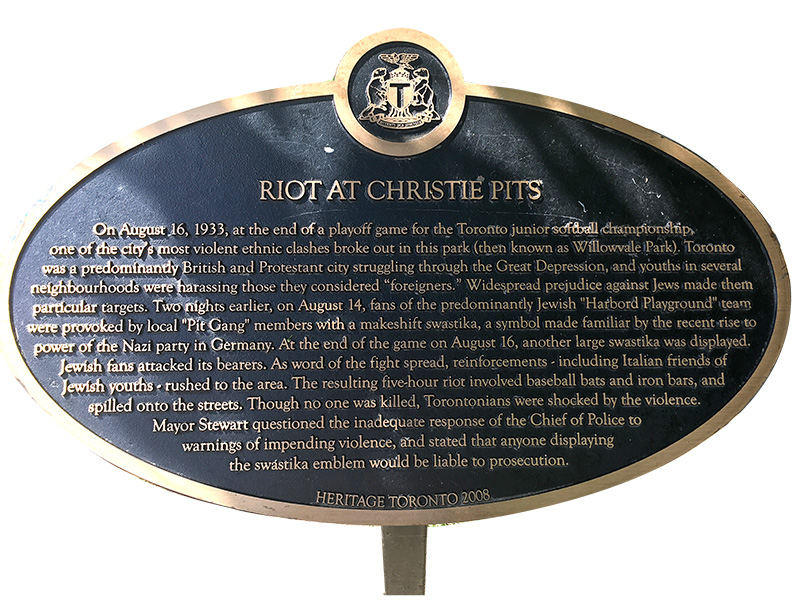When Cyril Levitt and William Shaffir published The Riot at Christie Pits in 1987, one Jewish Torontonian they spoke to described the event as “part of the mythology of the history of Toronto.”
At that time, it had been 54 years since the riot had occurred–long enough to feel the distance, but close enough that it was still personal for many people.
“Fathers and grandfathers tell and retell their heroic exploits during the ‘battle of Christie Pits’ to their children and grandchildren,” Levitt and Shaffir write. “The story has been passed across three generations.”
This week marks 90 years since the Christie Pits riot, which occurred on the night of Aug. 16, 1933. After a community baseball game, the Pit Gang, an antisemitic club in the neighbourhood, unfurled a large banner with a swastika painted on it. Jews who were present and expecting such an action tore down the banner, and six hours of street fighting ensued. The Jews and Italians fought together on one side, with Protestants on the other.
Very few Torontonians remain who would have been alive that night—and even fewer, if any, who would have been old enough to participate. If the riots were already part of the mythology of the history of Toronto when the book was published in the 1980s, when participants still lived to share the story, then what are we to make of it today?
If it were up to Cyril Levitt, we would do best to remember the Christie Pits riot as a concrete historical event situated in a specific time and context. That’s why he wrote the book, after all.

“People who’ve covered the Christie Pits riot tend to read it through the eyes of a more contemporary Toronto. And I don’t think that that does justice to the history of it and to the significance of it,” Levitt, a professor and former chair of the Department of Sociology at McMaster University, said in a recent interview with The CJN. “Things exist in a context. And if you don’t understand the context, you don’t understand that thing.”
Even the book he wrote with Shaffir can only begin to scratch the surface of the full historical context. But perhaps most important, said Levitt, was the situation in Germany–the election of Hitler and the Nazis and the subsequent persecution of Jews.
Contrary to what some people believe now, in 1933 the Toronto Jewish community knew all about the antisemitic atrocities occurring in Nazi Germany. Similarly, according to Levitt, “everybody in Toronto knew that the swastika was an antisemitic sign.”
Today, when Jewish Torontonians remark on Christie Pits, it is often with a mix of horror that such a violent antisemitic incident could have occurred here and pride in the local Jewish community for standing up for themselves. What many people don’t realize, said Harold Troper, a historian and professor emeritus at the University of Toronto, is that the broader Jewish community publicly condemned the Jews who used violence.
“At the time, the responsible and the respectable organized leadership of the community was aghast,” he said. “Maybe quietly, they wished that the kids had smashed some more noses, but publicly… [they] were condemning the violence.”
Rabbi Samuel Sachs, the head of the League for the Defence of Jewish Rights, which was the primary public face of Toronto’s Jewish community at the time, criticized the violence on all sides.
Rabbi Sachs is quoted in The Riot at Christie Pits:
“‘I have no accurate account,’ he said, ‘but from what I am informed some hotheads displayed an emblem which is hateful to our people, and some Jewish lads, equally hot-headed, tore it down.’ He was, he said, ‘deeply ashamed of the conduct of the Jewish youth who seem to have let their imagination run away with their judgment.’”
Despite the condemnation of the Jewish leadership at the time, the Jewish violence may be why the Christie Pits riot is so well remembered today. It is almost certainly not the biggest race riot in Canadian history, despite what has often been reported–the Vancouver anti-Asian riots in 1907 and Toronto anti-Greek riots in 1918 are thought to have been larger.
“The (anti-Greek riots) don’t have the same place in the city’s history, even though in some ways it was just as traumatic an experience in terms of its impact,” Troper said, referring to the fact that those riots caused the local Greek community to move to the Danforth neighbourhood of Toronto.
“So, it says something to the Jewish sense of memory that the Christie Pits riot still conjures up images and has this importance in Canadian Jewish life. And it speaks to a sense of pride today of people who fought back.”
On Aug. 16, Christie Pits will host a softball game, with food, and music, organized by Toronto city councillor Mike Colle. Gates open at 6 p.m., with the first pitch at 7 p.m.
